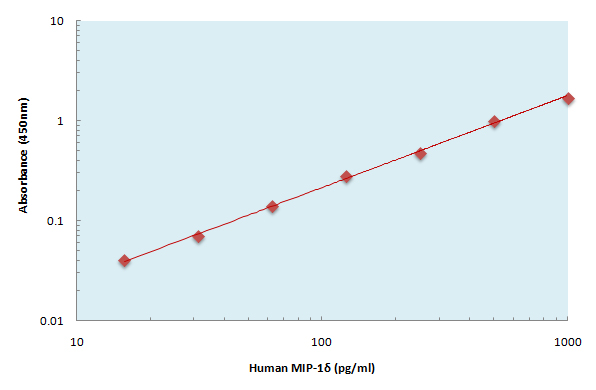Human MIP-1δ ELISA Kit
- Catalog No.:KE1153
- Applications:ELISA
- Reactivity:Human
- Gene Name:
- CCL15
- Protein Name:
- C-C motif chemokine 15
- Human Gene Id:
- 6359
- Human Swiss Prot No:
- Q16663
- Specificity:
- Sample Type for Cell Culture Supernates, Cell lysates, Tissue Lysates, Serum, EDTA Plasma, Heparin Plasma
- Storage Stability:
- 2-8°C/6 months
- Other Name:
- CCL15;MIP5;NCC3;SCYA15;C-C motif chemokine 15;Chemokine CC-2;HCC-2;Leukotactin-1;LKN-1;MIP-1 delta;Macrophage inflammatory protein 5;MIP-5;Mrp-2b;NCC-3;Small-inducible cytokine A15
- Detection Method:
- Colorimetric
- Background:
- function:Chemotactic factor that attracts T-cells and monocytes, but not neutrophils, eosinophils, or B-cells. Acts mainly via CC chemokine receptor CCR1. Also binds to CCR3. CCL15(22-92), CCL15(25-92) and CCL15(29-92) are more potent chemoattractants than the small-inducible cytokine A15.,function:Has weak activities on human monocytes and acts via receptors that also recognize MIP-1 alpha. It induced intracellular Ca(2+) changes and enzyme release, but no chemotaxis, at concentrations of 100-1,000 nM, and was inactive on T-lymphocytes, neutrophils, and eosinophil leukocytes. Enhances the proliferation of CD34 myeloid progenitor cells. The processed form HCC-1(9-74) is a chemotactic factor that attracts monocytes eosinophils, and T-cells and is a ligand for CCR1, CCR3 and CCR5.,online information:CCL14 entry,online information:CCL15 entry,PTM:HCC-1(1-74), but not HCC-1(3-74) and HCC-1(4-74), is partially O-glycosylated; the O-linked glycan consists of one Gal-GalNAc disaccharide, further modified by two N-acetylneuraminic acids.,PTM:The N-terminal processed forms HCC-1(3-74), HCC-1(4-74) and HCC-1(9-74) are produced in small amounts by proteolytic cleavage after secretion in blood.,similarity:Belongs to the intercrine beta (chemokine CC) family.,subunit:Monomer.,tissue specificity:Expressed constitutively in several normal tissues: spleen, liver, skeletal and heart muscle, gut, and bone marrow, present at high concentrations (1-80 nM) in plasma.,tissue specificity:Most abundant in heart, skeletal muscle and adrenal gland. Lower levels in placenta, liver, pancreas and bone marrow. CCL15(22-92), CCL15(25-92) and CCL15(29-92) are found in high levels in synovial fluids from rheumatoid patients.,
- Function:
- cellular ion homeostasis, cellular calcium ion homeostasis, cellular metal ion homeostasis, chemotaxis, immune response, cell-cell signaling, behavior, locomotory behavior, positive regulation of cell proliferation, cellular homeostasis, cellular cation homeostasis, cellular di-, tri-valent inorganic cation homeostasis, regulation of cell proliferation, taxis, homeostatic process, chemical homeostasis, ion homeostasis, metal ion homeostasis, di-, tri-valent inorganic cation homeostasis, calcium ion homeostasis, cation homeostasis, cellular chemical homeostasis,
- Subcellular Location:
- Secreted.
- Expression:
- Most abundant in heart, skeletal muscle and adrenal gland. Lower levels in placenta, liver, pancreas and bone marrow. CCL15(22-92), CCL15(25-92) and CCL15(29-92) are found in high levels in synovial fluids from rheumatoid patients.
- June 19-2018
- WESTERN IMMUNOBLOTTING PROTOCOL
- June 19-2018
- IMMUNOHISTOCHEMISTRY-PARAFFIN PROTOCOL
- June 19-2018
- IMMUNOFLUORESCENCE PROTOCOL
- September 08-2020
- FLOW-CYTOMEYRT-PROTOCOL
- May 20-2022
- Cell-Based ELISA│解您多样本WB检测之困扰
- July 13-2018
- CELL-BASED-ELISA-PROTOCOL-FOR-ACETYL-PROTEIN
- July 13-2018
- CELL-BASED-ELISA-PROTOCOL-FOR-PHOSPHO-PROTEIN
- July 13-2018
- Antibody-FAQs
- Products Images

- The Human MIP-1δ ELISA Kit allows for the detection and quantification of endogenous levels of natural and/or recombinant Human MIP-1δ proteins within the range of 16-1000 pg/ml.



